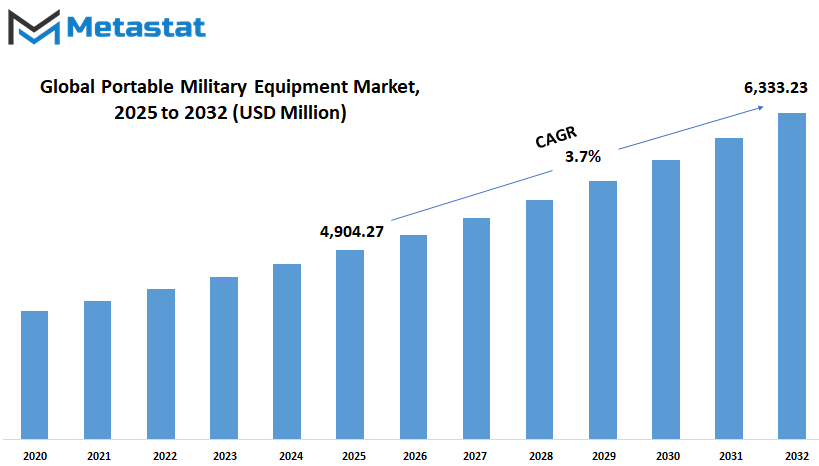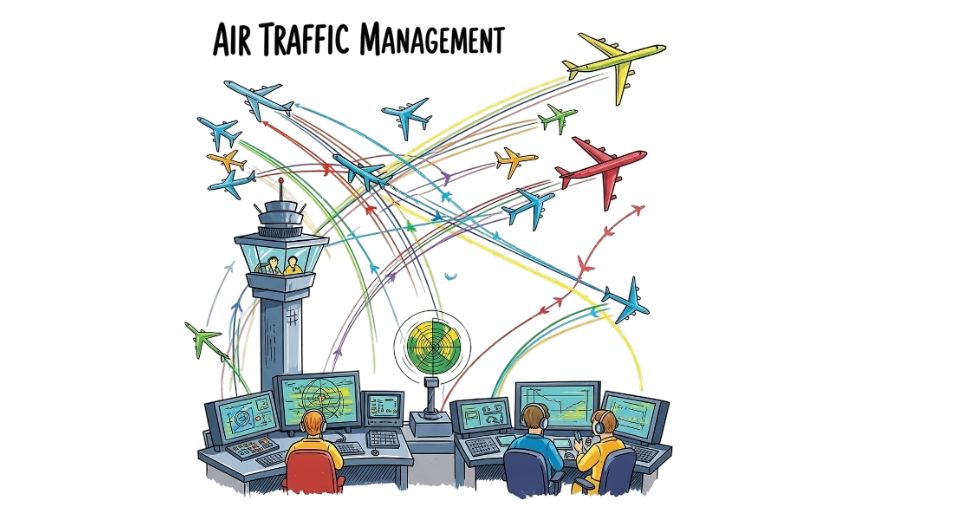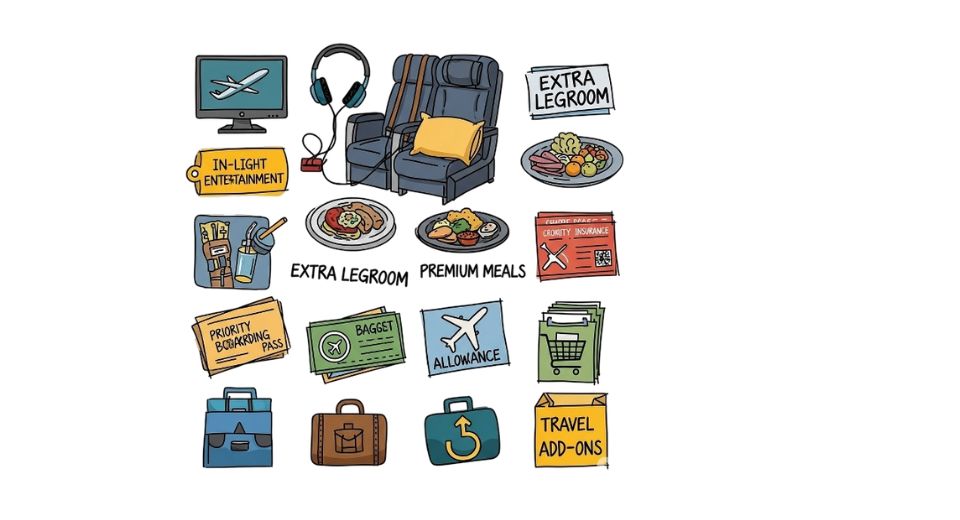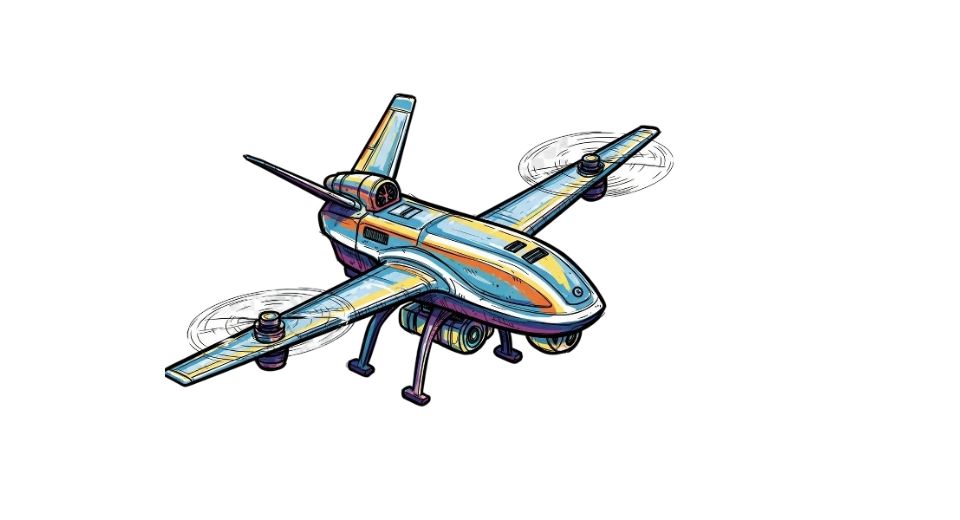MARKET OVERVIEW
The global portable military equipment market in the defense technology industry will be a key factor in enhancing tactical mobility and operational efficiency across different combat and non-combat environments. The market will target the production, manufacturing, and distribution of light, portable equipment and systems suitable for deployment in dynamic military operations. It will encompass a number of categories including communications equipment, monitoring equipment, power systems, protective equipment, and advanced field-deployable electronics, all made to be easily portable, deployable, and usable by single soldiers or small units in conventional and nonconventional environments. The global portable military equipment market will be marked by the emphasis on minimizing physical burden but maximizing capability.
As military plans evolve towards faster, more responsive forces, there will be greater emphasis on mobile and adaptive solutions. Asymmetrical warfare, peacekeeping, and border patrol missions will demand consistent and deployable equipment capable of performing consistently under tough environments for extended periods of time. This will influence future power systems, material science, and device miniaturization technological advancements that will push manufacturers to establish the balance between ruggedness and ergonomics. Military deployments to distant and contested regions will also drive the demand for advanced portable systems. Modular technologies facilitating autonomous or semi-autonomous capabilities will drive the global portable military equipment market.
For example, man-portable unmanned aerial vehicles, miniature radar kits, and field-mobile medical units will be more utilized since they can be used without high logistical signatures. This trend will encourage more innovation in energy autonomy, for example, solar-integrated equipment, as units seek to reduce dependence on traditional resupply channels during longer deployments. Standardization and interoperability will be strategic imperatives in the global portable military equipment market. Military units in many nations will increasingly require systems that can be integrated with those of allies to enable cooperative operations and information-exchange. Equipment capable of simple interfacing with central command posts or inter-unit networks will become the norm.
The digital foundation upon which these systems operate often embedded in wearable technology or ruggedized tablets will continue to advance, enabling soldiers to obtain and process information in real time without compromising mobility. The global portable military equipment market will also monitor sustained shifts in military doctrine emphasizing decentralized command and independent action at the unit level. Portable equipment that enables a unit to conduct independent action over a prolonged period will become totally necessary. Those tools will support active battlefield operations as much as humanitarian missions, disaster relief, and operations in urban areas. In consequence, future development will increasingly incorporate traditional military requirements and multirole design considerations, extending the limits of equipment utility.
Conformance to global defense standards and rigorous field testing will continue to be the norm for access to the global portable military equipment market. Established entrants and new defense contractors alike will be expected to demonstrate performance reliability, safety records, and adaptability in multi-theater use cases. As the face of war and national security threats changes, so too will the market, offering solutions tailored to operational uncertainty and logistical complexity. Ultimately, the global portable military equipment market will be a critical intersection of defense innovation, tactical performance, and field adaptability, driven by technological advancement and mission-specific needs.
Global portable military equipment market is estimated to reach $6,333.23 Million by 2032; growing at a CAGR of 3.7% from 2025 to 2032.

GROWTH FACTORS
As global defense strategies increasingly turn towards greater responsiveness and efficiency, the demand for lighter, smarter, and more flexible equipment has increased consistently. One of the most important markets demonstrating this trend is the global portable military equipment market. This market is concerned with developing equipment that not only assists soldiers in their operations but also allows them to move more freely, react more quickly, and remain connected in hostile environments. The increased need for soldier modernization and enhanced battlefield mobility is at the core of determining the future of this market. Current warfare is no longer reliant on heavy vehicles or fixed systems.
Quick adaptability and mobility are essential today. This is the reason why the world's militaries are putting greater emphasis on portable equipment that minimizes physical stress on soldiers while maximizing their capabilities. Lightweight communication devices, wearable sensors, power sources, and small-size protective equipment are being developed more and more to assist in safety as well as mission accomplishment. With these developments, the military forces are becoming more agile and prepared to operate in various scenarios. Rising emphasis on swift deployment and mission adaptability is another key factor which promotes the growth of the global portable military equipment market. With uncertain dangers and rapidly evolving circumstances, defense troops need to be able to respond at a moment's notice.
Portable equipment enables troops to go in with the tools they require without being encumbered by larger equipment. For humanitarian interventions or combat operations, the ability to take mission-essential equipment in a space-saving and efficient manner has become crucial. While such developments hold much promise, there are, nonetheless, some issues that may act as an impediment to further advancement. One of the largest hurdles is the significant expense of creating cutting-edge portable technology. Creating technology that is light yet durable typically requires specialty materials and high-end engineering, which can be expensive.
Battery life and power supply constraints during field missions are also a problem. Equipment that is reliable to operate for long periods is what soldiers require, particularly where recharge facilities are limited. To look forward, the future promises a number of encouraging prospects. Wearable electronics and energy-efficient systems will make improved functionality and comfort possible. The technologies promise to give way to longer battery life, reduced weight, and intelligent systems capable of adjusting to real-time conditions. As defense demands become increasingly sophisticated, the global portable military equipment market will find itself undergoing further development courtesy of innovation and an ever-present demand for flexible, mobile, and intelligent solutions in the field.
MARKET SEGMENTATION
By Type
The global portable military equipment market is gradually determining the future of defense systems, driven by the imperative of mobility, flexibility, and rapid response. Because of the accelerated pace of technological advancement and changing military strategies, portable equipment is in increasingly high demand. Armies across the globe are looking for equipment that will be able to support ground soldiers without weighing them down, enhancing effectiveness as well as security. The demand for dependable, light, and compact systems has never been greater as battle situations become more unpredictable and sophisticated. This sector encompasses a number of essential categories of hardware.
Communication Equipment is important in enabling groups to remain in constant communication, even in outlying or hazardous areas. The market worth of this segment is projected to rise to USD 1,398.21 million by 2025, a reflection of its growing relevance. Command and Control Systems support real-time decision-making, allowing units to react efficiently and promptly. They are expected to be worth USD 508.08 million during the same year. As missions increasingly rely on visual information, Imaging Systems have become paramount. Their ability to provide sharp pictures across various surroundings is driving expansion, with a forecast value of USD 996.30 million in 2025. Navigation Systems are a critical component as well, helping personnel travel safely and effectively across unfamiliar or difficult terrain.
The systems will be worth around USD 486.75 million, capturing the growth in demand for accurate location tracking. Protection and Surveillance Systems will play an even more significant role in future military operations. These gadgets offer protection and intelligence in the sense that they safeguard soldiers and keep track of large areas, valued at USD 1,243.48 million. Lastly, other handheld gadgets that fall outside these categories also contribute to this expanding market, valued at USD 271.45 million. In the coming future, the global portable military equipment market will be sure to keep on expanding with defense industries focusing more on flexibility and technology upgrades. Military soldiers will continue investing in equipment that enhances performance and reduces physical pressure on soldiers.
The focus will still be on equipment that is light, user-friendly, and robust in harsh situations. This shift is not so much about improving tools, but about changing the mission dynamics. The newer challenges that arise, the better equipped handheld military devices will make forces respond more quickly, stay safer, and perform better on the battlefield.
By Platform
The global portable military equipment market will keep expanding and evolving as the defense future moves toward more mobile, compact, and sophisticated systems. As the demand for greater flexibility and quick deployment increases, the market will shift away from conventional configurations to offer equipment and technology that can be easily transported, utilized in the field, and integrated with current communication and tracking systems. These advances are not only specific to current requirements but also conceived in terms of future war and security doctrines. Platform-wise, this market is segmented into three major areas: airborne, naval, and land.
These three segments perform distinct functions, and each one of them has its own requirements. The airborne component will be enhanced by light equipment that enables paratroopers and aircraft personnel to function effectively while remaining linked to central command centers. The equipment will consist of communication systems, monitoring equipment, and equipment for rapid installation and removal during operations. This will enable forces to remain responsive and respond quickly in a variety of situations, including those in remote areas. The naval branch is concerned with systems that aid operations at sea, where the weather can be severe and the availability of resources is low. In such environments, handheld devices will enable naval operators to execute tasks more easily on a ship or in amphibious operations. Such devices must withstand saltwater corrosion, pressure, and other aquatic demands.
There will also be emphasis on communication equipment and detection hardware that can identify surface and underwater threats. The terrain segment is also an important part of the market, as ground troops tend to depend most on handheld tools. Troops require light, dependable, and sturdy equipment that will not hinder their efforts. This may be night vision devices, power supplies, tracking devices, and high-tech protective equipment. The more technology advances, the more devices will have onboard intelligence to enable soldiers to make rapid decisions on the battlefield.
Moving forward, the future of the global portable military equipment market will be determined by demand for smarter, more variable tools. The emphasis will not merely be on how to lighten the load but on how to pack more value into less.
This will drive the industry to develop products that are not only portable but deeply integrated with larger systems of data, comms, and immediate response. As dangers become more sophisticated, so will the requirement for equipment enabling the military to remain one step ahead.
By Application
The global portable military equipment market is expected to expand enormously as the requirements of contemporary armed forces evolve continuously. Portable equipment is instrumental in enhancing the efficiency and mobility of military forces under varied circumstances. Considering the uses of this market, a number of areas emerge as of prime importance to its future growth.
One of the foremost uses is Intelligence, Surveillance, and Reconnaissance (ISR). With military operations increasingly reliant on timely and accurate intelligence, the need for portable ISR systems will grow. Soldiers use these devices to acquire data rapidly and effectively, frequently in austere or remote areas. Portable systems enabling ISR will enable forces to track threats and activity more accurately, resulting in improved decision-making in the field.
Combat operations also gain significantly from portable gear. Troops require equipment that is light, rugged, and easy to transport without sacrificing functionality. The future will probably witness improvements in materials and technology that render this equipment more dependable and versatile. This implies that troops will be better equipped to adapt to different combat situations, whether in urban environments or open fields.
Search and rescue operations will still depend on handheld devices to find and rescue people in distress. Such equipment may be communication equipment, medical supplies, and navigation equipment that enable teams to get to, and help distressed individuals sooner. With improving technology, such equipment will be more efficient and user-friendly, enhancing the rescue success rates.
Training and simulation are another significant field where portable military hardware will play a significant role. Simulative conditions enable soldiers to train for real-life scenarios without the dangers of real combat. Portable systems facilitating this type of training will enable more lifelike and adaptable exercises, which will prepare personnel more effectively for the threats they may encounter.
Transportation and logistics entail movement and provision of materials and troops, and portable equipment again plays an important part here. Equipment used to track, monitor, and secure supplies will streamline operations and prevent delays. As supply chains become increasingly complicated, portable technology will ensure that everything reaches where it is supposed to be on schedule.
Finally, command and control systems are needed to coordinate military operations. Field-supported communication and decision-making equipment that is portable will be crucial to sustaining an advantage over competitors. In the future, these systems will be more integrated and user-friendly, allowing commanders to respond more quickly and accurately.
In general, the global portable military equipment market will keep expanding and evolving, spurred by the demand for improved, more versatile equipment that enables military forces to do their jobs more efficiently in a variety of applications.
By End User
The global portable military equipment market is likely to grow significantly as militaries across the globe continue to modernize and evolve to new threats. The market is directed towards equipment that is portable, easily carried, or transported to enable military troops to remain agile and efficient throughout operations. As technology improves, the need for lighter, tougher, and multipurpose portable equipment will rise. Every branch of the military Army, Navy, Air Force, and Special Forces will have specific requirements that will inspire the creation and utilization of such equipment. The Army, as the largest and most adaptable branch, will need equipment that is transportable and accommodates ground-based operations in a wide range of environments and terrains.
Troops will require equipment that improves their communication, direction-finding capabilities, and ability to survive in hostile environments. Portable equipment like high-tech communication devices, night vision gear, and light-weight body armor will get more advanced, keeping soldiers connected and protected. With persistent conflicts and peacekeeping operations globally, the Army's position in the global portable military equipment market will remain pivotal. The Navy will also drive the market by requiring equipment that can be used in maritime and coastal operations. Portability in naval equipment refers to its ability to endure tough sea conditions and still be light enough to transport and use on ships or during amphibious operations.
The Navy will seek equipment that aids navigation, underwater reconnaissance, and secure communication. As naval operations move into greater surveillance and quick-response missions, the need for smaller, reliable, and high-performance portable tools will grow. The Air Force will emphasize portable equipment that enhances aerial mission and aircrew as well as ground operations. Portable equipment used for navigation, communications, and survival will be necessary for pilots and crew members involved in search and rescue or tactical operations. Light-weight devices that are portable and can be operated in various types of environments will be in great demand.
The expanded role of the Air Force in rapid deployment and technologically sophisticated warfare will drive innovations in portable military gear. Special Forces will define the market as they demand highly specialized and adaptive portable equipment for clandestine and high-risk operations. Their gear must be compact, heavy-duty, and multi-functional to respond to unexpected environments. Special Forces personnel tend to operate behind enemy lines or in hostile environments, so stealth, communication, and mobility features will top their list of needs. Their specific requirements will fuel the innovation of advanced technology in portable military gear. By and large, the global portable military equipment market will keep on rising as every arm of the military requires better, lighter, and more efficient weapons to enhance operations success. Any future innovation is expected to come in the direction of blending technology, reliability, and usability such that military professionals can take what they require on the battlefield without sacrificing mobility. This will remain a significant determinant of how armies prepare and perform missions in the coming years.
|
Forecast Period |
2025-2032 |
|
Market Size in 2025 |
$ 4,904.27 million |
|
Market Size by 2032 |
$ 6,333.23 Million |
|
Growth Rate from 2025 to 2032 |
3.7% |
|
Base Year |
2025 |
|
Regions Covered |
North America, Europe, Asia-Pacific, South America, Middle East & Africa |
REGIONAL ANALYSIS
The global portable military equipment market will exhibit significant growth in different regions, each driven by distinct factors that will dictate demand and evolution. North America, particularly the United States, will continue to be a prominent player as a result of its robust defense sector and continued investments in cutting-edge military technology. The emphasis in this region likely will be on modernizing and bringing together mobile equipment that is designed to increase mobility and operational effectiveness for military forces. Canada and Mexico will also play a role in market expansion, but their effect likely will be less than that of the U.S., with activity focused on modernization and integration within North American defense partnerships. Europe's market will keep improving with nations like the UK, Germany, France, and Italy leading the way.
These countries will prioritize innovation in lightweight, strong, and multi-purpose military equipment suitable for varying environments. European nations can also focus on cooperation to create equipment that is NATO-compliant, enhancing joint operations and peacekeeping interventions. The remainder of Europe will evolve towards adopting these technologies, contributing to the region's defense readiness as a whole. In the Asia-Pacific region, rapid modernization and rising defense expenditures by nations such as India, China, Japan, and South Korea will have a large impact.
These nations will emphasize developing their military capabilities in terms of portable equipment to enable rapid deployment and new communication. The region will most likely experience greater emphasis on equipment that provides versatility and flexibility to various climates and types of terrain. The rest of the Asia-Pacific will follow suit slowly, bolstering regional security measures. South America's market growth will be driven by Brazil and Argentina, with a focus on enhancing border security and disaster relief capabilities. Tactical military equipment that is portable will be crucial in these endeavors, offering the tools needed for mobility and tactical support in operations. The remainder of South America will continue to build its military assets, but at a slower rate. In the Middle East and Africa, Gulf Cooperation Council states, as well as Egypt and South Africa, will spend on transportable military assets to counter security needs and enhance quick response units.
The remainder of the Middle East and Africa will experience slow growth, with countries building up defense infrastructure to be able to respond better to regional conflicts and peacekeeping missions. In total, these regional dynamics will shape the international market, both taking into account current demands and future aspirations.

COMPETITIVE PLAYERS
The global portable military equipment market will remain a subject of major interest as nations globally invest in high-tech solutions for their militaries. This market entails a range of tools and devices meant to assist soldiers in the field by improving their mobility, communication, and protection. Firms within this industry are continuously improving the state of technology to design equipment that is more durable, light, and efficient, satisfying the constantly increasing needs of contemporary warfare. Two of the primary drivers for the future direction of this industry are established defense companies that boast innovation and dependability. Lockheed Martin Corporation, for instance, will likely use its considerable experience in defense technology to come up with portable systems that complement other military systems easily. In the same manner, Codan Communications aims to develop communications devices that will retain high levels of connectivity in harsh terrain, a key aspect for soldiers that often work in far-flung or hostile environments.
Leonardo S.p.A. is yet another prominent company that will be moving the market forward with its emphasis on flexible equipment that facilitates both ground and airborne applications. Their efforts are to help make portable equipment a functioning powerhouse regardless of conditions so that soldiers have vital information without carrying excess weight or complexity. General Dynamics Corporation, with its wide portfolio of military products, will contribute significantly by making portable equipment more durable and functional so that troops can trust their equipment to be with them during longer missions. BAE Systems plc and Thales Group will keep building technologies around protecting and perceiving the soldier's environment.
Their transportable military gear will be integrated with high-end sensors and intuitive user interfaces, providing more rapid battlefield decision-making capabilities. Saab AB and L3 Technologies, Inc. will be making inputs by enhancing not just the use but also the adaptability of equipment, with the ability to be tailored for various operational demands. Elbit Systems Ltd. and Rheinmetall AG will also shape the market through emphasis on the incorporation of new materials and electronics that enhance the portability and security of equipment. These firms appreciate the value of creating military equipment that not only complies with the existing standards but also makes future standards obsolete.
In the future, competitive participants in the global portable military equipment market will define the character of how the military operates, providing equipment that makes soldiers more connected, safe, and efficient. As technology advances, the market will see new innovations that will redefine portable military equipment, making it a cornerstone of defense policies globally.
Portable Military Equipment Market Key Segments:
By Type
- Communication Equipment
- Command and Control Systems
- Imaging Systems
- Navigation Systems
- Protection and Surveillance Systems
- Others
By Platform
- Airborne
- Naval
- Land
By Application
- Intelligence, Surveillance, and Reconnaissance (ISR)
- Combat Operations
- Search and Rescue
- Training and Simulation
- Logistics and Transportation
- Command and Control
By End User
- Army
- Navy
- Air Force
- Special Forces
Key Global Portable Military Equipment Industry Players
- Lockheed Martin Corporation
- Codan Communications
- Leonardo S.p.A.
- General Dynamics Corporation
- BAE Systems plc
- Thales Group
- Saab AB
- L3 Technologies, Inc.
- Elbit Systems Ltd.
- Rheinmetall AG
WHAT REPORT PROVIDES
- Full in-depth analysis of the parent Industry
- Important changes in market and its dynamics
- Segmentation details of the market
- Former, on-going, and projected market analysis in terms of volume and value
- Assessment of niche industry developments
- Market share analysis
- Key strategies of major players
- Emerging segments and regional growth potential














 US: +1 3023308252
US: +1 3023308252






